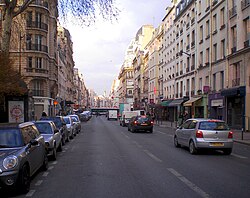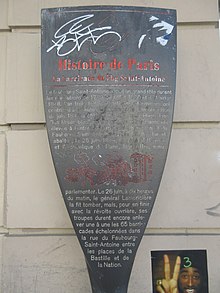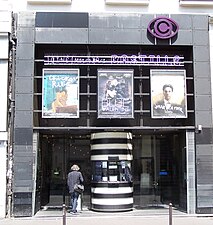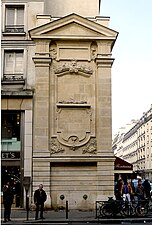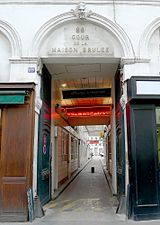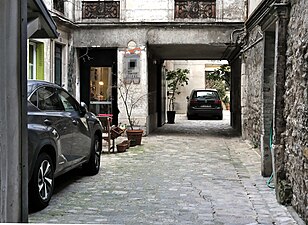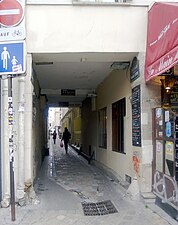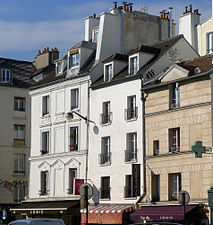Rue du Faubourg Saint-Antoine
Coordinates: 48 ° 51 ′ 1.5 ″ N , 2 ° 22 ′ 53.6 ″ E
| Rue du Faubourg Saint-Antoine | |
|---|---|
| location | |
| Arrondissement | 11th and 12th |
| quarter | Roquette Sainte-Marguerite Quinze-Vingts Picpus |
| Beginning | 2, rue de la Roquette and 1, rue de Charenton |
| The End | 1, Place de la Nation |
| morphology | |
| length | 1810 m |
| width | 17 m to 30 m |
| history | |
| Original names | Chaussée Saint-Antoine |
| Coding | |
| Paris | 3540 |
The Rue du Faubourg Saint-Antoine ( German street of the suburb of St. Anthony ) is a street in Paris . X It should not be confused with the Rue Saint-Antoine , which leads from the center to the Bastille.
location
The street offers (and offered) a good opportunity to erect barricades because of the narrow passages (17 to 30 m) in connection with the labyrinthine aspect of the adjacent streets .
It borders the Place de la Bastille and extends from the Rue de Charenton and the Rue de la Roquette to the Place de la Nation . There are fountains at the intersection with Rue de Charonne and Rue de Montreuil . In the eastern part of the street it is bordered by trees.
The street can be reached by metro via the Bastille , Ledru-Rollin , Faidherbe - Chaligny and Nation stations .
Name origin
The Rue du Faubourg Saint-Antoine owes its name to the fact that the suburb of this name, outside the city walls of Charles V ( French Enceinte de Charles V ), with the Abbey of Saint-Antoine-des-Champs (destroyed in the 18th century ) Association.
history
The Rue du Faubourg Saint-Antoine is one of the oldest streets in Paris, but was for a long time outside the Paris city walls , as the name suggests; because Faubourg means suburb . Nevertheless, the street has always had an exposed location because it had to be driven through on the way from the center of Paris to the east in order to get to Vincennes and its castle .
The suburb of Saint-Antoine grew in the Middle Ages around the Saint-Antoine-des-Champs monastery , which was built towards the end of the 12th century.
The real growth of the suburb of Saint-Antoine began in the 15th century when, on special instructions from the king, all craftsmen living here obtained tax exemption. This special privilege, as well as the geographical proximity to the Seine , via which all timber transports to Paris at that time, made the Rue du Faubourg Saint-Antoine the Parisian main street of the wood and furniture craftsmen who settled in the backyards and adjoining alleys.
Thanks to the furniture makers located here , the street gained national fame and so the famous École Boulle , which is characteristic of French furniture making , is almost logically located in this street. Even though many of the workshops have since disappeared, furniture making is still present, however mainly through shops and showrooms .
Attractions
Odd house numbers
The north side of the street with the odd house numbers belongs to the 11th arrondissement .
- Nos. 31–39: a set of five buildings that were declared a monument historique in 1996 .
- No. 45–57: Courtyards: Cour Saint-Louis , Cour du Nom-de-Jésus , Cour Viguès ,
- No. 71–95: Inner courtyards: Cour des Shadoks , Cour de l'Étoile-d'Or , Cour des Trois-Frères , Cour de la Maison-Brûlée , Cour de l'Ours
- No. 157: First adult education center in France
- before No. 211–213: Fontaine de la Petite-Halle (also called Fontaine de Montreuil)
La Bastille Cinema (No. 5)
Fontaine Trogneux ou de Charonne , (No. 61), Jean Beausire (1719)
Cour des Shadoks (No. 71)
Entrance to the Cour des Trois-Frères (No. 81–83)
Entrance to the Cour de la Maison-Brûlée (No. 89)
The bear above the entrance to the Cour de l'Ours (No. 95)
Entrance to the Passage de la Main-d'Or (No. 133)
Fontaine de Montreuil , also called Fontaine de la Petite-Halle (No. 211–213)
Even house numbers
The southern side of the street with the even house numbers belongs to the 12th arrondissement .
- No. 56: Cour du Bel-Air
- No. 66: Passage du Chantier
- No. 74: Cour des Bourguignons. This huge and impressive industrial yard was built in 1880 and 1885 as a sawmill by Mr. Holland. It is dominated by a tall brick chimney and is lined with symmetrically arranged buildings with (listed) glazed metal canopies. Since 2009, the Île-de-France region has set up a design center here ( French center ressource du design francilien ).
- No. 84: Birthplace of the sculptor Pierre-Jules Mêne (1810–1879)
- No. 112: Square Armand-Trousseau , a place with a bandstand and green area
- No. 182/186: Place du Docteur-Antoine-Béclère , entrance to the Hôpital Saint-Antoine
- No. 210: Center de formation des journalistes (CFJ)
- No. 254: Boarding school of the famous boys' choir Les Petits Chanteurs à la Croix de Bois .
- No. 262: Fondation Eugène-Napoléon and Jardin de la Fondation Eugène-Napoléon , a foundation by Eugénie de Montijo with an adjoining garden, which is still in operation today and in which a vocational high school ( French Lycée professionel ), a primary school ( French école primaire ), a kindergarten ( French école maternelle ) and a student residence.
Entrance to the Passage de la Boule-Blanche , no .: 50
Entrance to the Cour du Bel-Air , no .: 56
Building no.170bis: the former porter's lodge at Abbaye Saint-Antoine ,
Individual evidence
- ↑ a b Alleys and passageways of the Faubourg Saint-Antoine (English; article with update from November 27, 2013)
- ↑ Discover Paris by metro . Éditions du Chêne, 2012, p. 234f ISBN 978-2-81230-552-8
- ↑ Immeubles, 31, 33, 35, 37, 39 rue du Faubourg-Saint-Antoine in the Base Mérimée of the French Ministry of Culture (French).
- ^ Stanislas Lami , Dictionnaire des sculpteurs de l'École française du dix-neuvième siècle , vol. 3, Librairie ancienne Honoré Champion, Paris, 1916.
